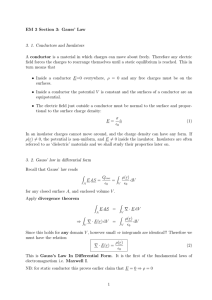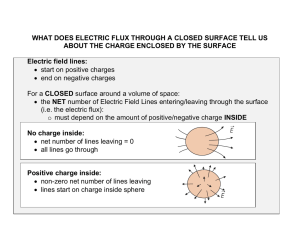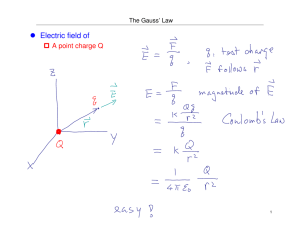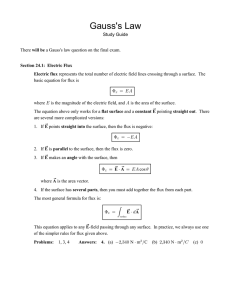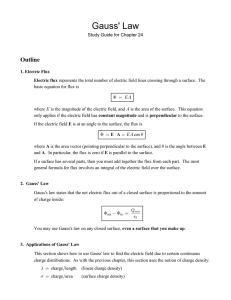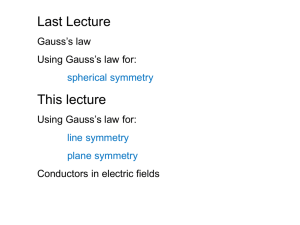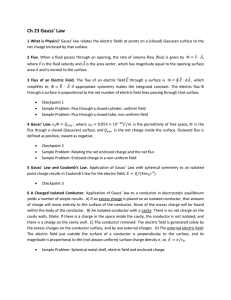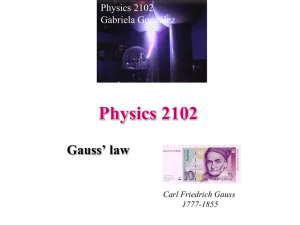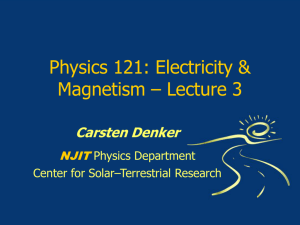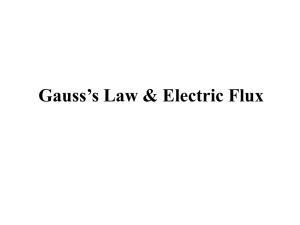pptx
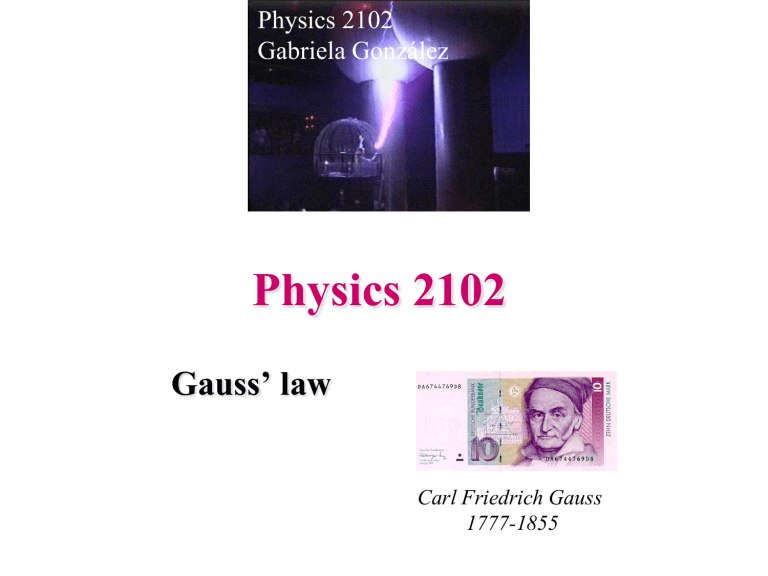
Physics 2102
Gabriela González
Physics 2102
Gauss’ law
Carl Friedrich Gauss
1777-1855
Electric Flux
• Electric Flux
A surface integral!
F
r
E
d r
A
•
CLOSED surfaces:
OUTWARDS
– Inward E gives negative
F
–
Outward E gives positive
F
Gauss’ Law
• Consider any ARBITRARY
CLOSED surface S -- NOTE: this does NOT have to be a
“real” physical object!
• The TOTAL ELECTRIC FLUX through S is proportional to the
TOTAL CHARGE
ENCLOSED!
• The results of a complicated integral is a very simple formula: it avoids long calculations!
F
Surface
S
E
d A
q
0
(One of Maxwell’s 4 equations)
Gauss’ law, using symmetry
Shell theorem
Spherical symmetry
Planar symmetry
Two infinite planes
E
+
= s
/2
0
E
-
= s
/2
0
A uniform field!
E=0
+Q
E= s
/
0
-
Q
E=0
Insulating and conducting planes
Q E
s
2
0
Q
2 A
0
Insulating plate: charge distributed homogeneously.
Q/2
E
s
0
Q
2 A
0
Conducting plate: charge distributed on the outer surfaces.
Gauss’ Law:
Cylindrical symmetry
• Charge of 10 C is uniformly spread over a line of length L = 1 m.
E = ?
R = 1 mm
• Use Gauss’ Law to compute magnitude of E at a perpendicular distance of 1 mm from the center of the line.
1 m
• Approximate as infinitely long line -- E radiates outwards.
• Choose cylindrical surface of radius R, length L co-axial with line of charge.
Gauss’ Law: cylindrical symmetry (cont)
• Approximate as infinitely long line -- E radiates outwards.
• Choose cylindrical surface of radius r, length h co-axial with line of charge.
F
| E | A
| E | 2
r h
F q
0
h
0
| E |
h
2
0 rh
2
0 r
2 k
R
E y
Compare with exact calculation!
k
r
L / 2
-
L / 2
( r
2 dx
x
2
)
3 / 2
k
r
r
2 x x
2 r
2
L / 2
-
L / 2
k
L r r
2
( L /2)
2
=Q/L r
if the line is infinitely long (L >> r)…
E y
k
L r ( L /2)
2
2 k
r
Gauss’ law, using symmetry
Question
The figure shows four solid spheres, each with charge Q uniformly distributed through its volume.
(a) Rank the spheres according to their volume charge density, greatest first.
The figure also shows a point P for each sphere, all at the same distance from the center of the sphere.
(b) Rank the spheres according to the magnitude of the electric field they produce at point P , greatest first.
Question
Three infinite nonconducting sheets, with uniform positive surface charge densities σ, 2σ, and 3σ, are arranged to be parallel. What is their order, from left to right, if the electric field produced by them is zero in one region and has magnitude E= 2 s
/
0 in another region?
Ch 23 Summary:
• We define electric flux through a surface: F
r
E
d r
A
• Gauss’ law provides a very direct way to compute the electric flux : F q ins
/
0
• In situations with symmetry , knowing the flux allows to compute the fields reasonably easily:
– Uniform field of an insulating plate: s
/2
0, plate: s
/
0.
.
– Cylindrical field of a long wire: 2k
/r ins
/r 2
; of a conducting
• Properties of conductors
: field inside is zero; excess charges are always on the surface; field on the surface is perpendicular and E= s
/
0.
Problem
In the figure below, a nonconducting spherical shell of inner radius a and outer radius b has (within its thickness) a positive volume charge density ρ = A/r, where A is a constant and r is the distance from the center of the shell. In addition, a small ball of charge q is located at the center. What constant A produces a uniform electric field in the shell a <r <b ?
Electric potential energy, electric potential
Electric potential energy of a system =
=
work (against electrostatic forces) needed to needed to build the system
U=
-
W
Electric potential difference between two points = work per unit charge needed to move a charge between the two points:
D
V = V f
-V i
=
-
W/q
Electric potential energy, electric potential
Units : [U] = [W]=Joules;
[V]=[W/q] = Joules/C= Nm/C= Volts
[E]= N/C = Vm
1eV = work needed to move an electron through a potential difference of 1V:
W=q
D
V = e x 1V
= 1.60 10 -19 C x 1J/C = 1.60 10 -19 J
Electric field lines and equipotential surfaces
Given a charged system, we can:
• calculate the electric field everywhere in space
• calculate the potential difference between every point and a point where V=0
• draw electric field lines
• draw equipotential surfaces http://phet.colorado.edu/en/simulation/charges-and-fields
